Skoda Fabia vs VW Polo – Which one offers the better deal?
Two cars, one duel: Skoda Fabia meets VW Polo.
Which one wins in performance, efficiency and value for money? Find out now!
Costs and Efficiency:
Price and efficiency are key factors when choosing a car – and this is often where the real differences emerge.
Skoda Fabia has a minimal advantage in terms of price – it starts at 16900 £, while the VW Polo costs 17000 £. That’s a price difference of around 124 £.
Fuel consumption also shows a difference: Skoda Fabia manages with 4.90 L and is therefore minimal more efficient than the VW Polo with 5.10 L. The difference is about 0.20 L per 100 km.
Engine and Performance:
Power, torque and acceleration are the classic benchmarks for car enthusiasts – and here, some clear differences start to show.
When it comes to engine power, the VW Polo has a somewhat edge – offering 207 HP compared to 177 HP. That’s roughly 30 HP more horsepower.
In acceleration from 0 to 100 km/h, the VW Polo is a bit quicker – completing the sprint in 6.50 s, while the Skoda Fabia takes 7.40 s. That’s about 0.90 s faster.
In terms of top speed, the VW Polo performs barely noticeable better – reaching 240 km/h, while the Skoda Fabia tops out at 228 km/h. The difference is around 12 km/h.
There’s also a difference in torque: VW Polo pulls noticeable stronger with 320 Nm compared to 250 Nm. That’s about 70 Nm difference.
Space and Everyday Use:
Cabin size, boot volume and payload all play a role in everyday practicality. Here, comfort and flexibility make the difference.
Both vehicles offer seating for 5 people.
Both models weigh roughly the same – around 1143 kg.
In terms of boot space, the Skoda Fabia offers hardly perceptible more room – 380 L compared to 351 L. That’s a difference of about 29 L.
In maximum load capacity, the Skoda Fabia performs hardly perceptible better – up to 1190 L, which is about 65 L more than the VW Polo.
When it comes to payload, VW Polo slight takes the win – 457 kg compared to 437 kg. That’s a difference of about 20 kg.
Who comes out on top?
Overall, the VW Polo shows itself to be is largely superior and secures the title of DriveDuel Champion.
It convinces with the more balanced overall package and proves to be the more versatile choice for everyday use.
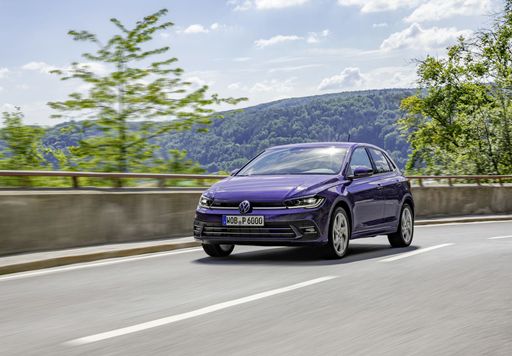 @ Volkswagen AG / VW Media
@ Volkswagen AG / VW Media
VW Polo
Skoda Fabia
The Skoda Fabia is a clever, no-nonsense small car that turns everyday chores into a breeze thanks to smart packaging and a surprisingly roomy cabin. It won’t set your pulses racing, but it’s a consistently sensible choice — reliable, easy to live with and blessed with a few neat tricks that make city life less faff.
details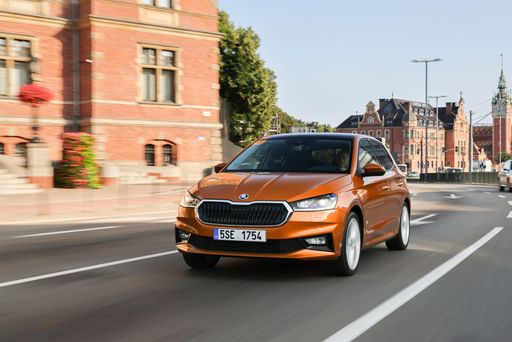 @ Škoda Auto a.s. / Škoda Storyboard
@ Škoda Auto a.s. / Škoda Storyboard
 @ Škoda Auto a.s. / Škoda Storyboard
@ Škoda Auto a.s. / Škoda Storyboard
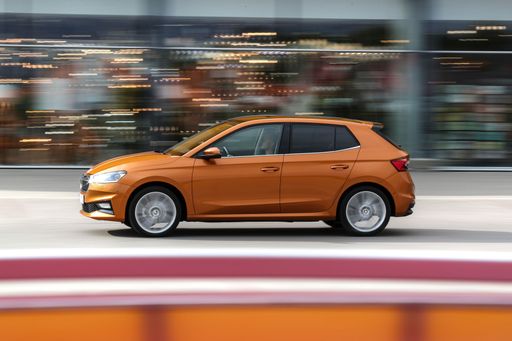 @ Škoda Auto a.s. / Škoda Storyboard
@ Škoda Auto a.s. / Škoda Storyboard
 @ Škoda Auto a.s. / Škoda Storyboard
@ Škoda Auto a.s. / Škoda Storyboard
 @ Škoda Auto a.s. / Škoda Storyboard
@ Škoda Auto a.s. / Škoda Storyboard
VW Polo
The Polo is a small car with surprisingly grown-up refinement, delivering comfortable packaging, crisp handling and a build quality that punches above its class. For buyers who want a practical, fuss-free hatch that still feels a little premium, it’s a sensible, slightly cheeky choice you’ll enjoy every day.
details @ Volkswagen AG / VW Media
@ Volkswagen AG / VW Media
 @ Volkswagen AG / VW Media
@ Volkswagen AG / VW Media
 @ Volkswagen AG / VW Media
@ Volkswagen AG / VW Media
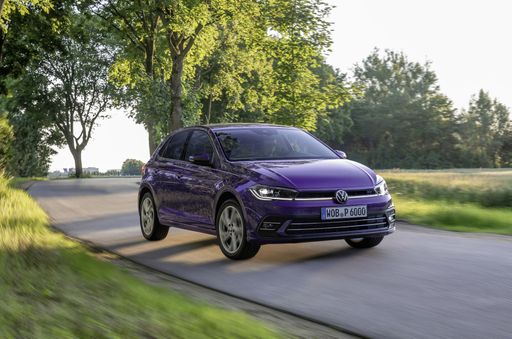 @ Volkswagen AG / VW Media
@ Volkswagen AG / VW Media
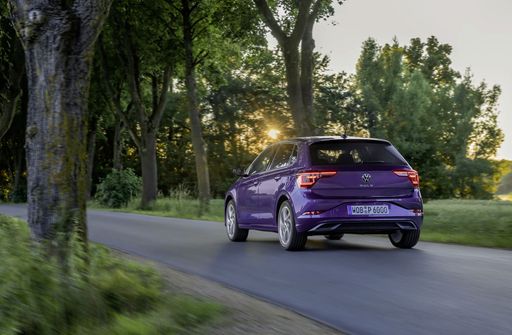 @ Volkswagen AG / VW Media
@ Volkswagen AG / VW Media
 @ Volkswagen AG / VW Media
@ Volkswagen AG / VW Media
 @ Škoda Auto a.s. / Škoda Storyboard
@ Škoda Auto a.s. / Škoda Storyboard
|
 @ Volkswagen AG / VW Media
@ Volkswagen AG / VW Media
|
|
|
|
Costs and Consumption |
|
|---|---|
|
Price
16900 - 30500 £
|
Price
17000 - 30400 £
|
|
Consumption L/100km
4.9 - 5.6 L
|
Consumption L/100km
5.1 - 6.5 L
|
|
Consumption kWh/100km
-
|
Consumption kWh/100km
-
|
|
Electric Range
-
|
Electric Range
-
|
|
Battery Capacity
-
|
Battery Capacity
-
|
|
co2
112 - 126 g/km
|
co2
116 - 148 g/km
|
|
Fuel tank capacity
40 L
|
Fuel tank capacity
40 L
|
Dimensions and Body |
|
|---|---|
|
Body Type
Hatchback
|
Body Type
Hatchback
|
|
Seats
5
|
Seats
5
|
|
Doors
5
|
Doors
5
|
|
Curb weight
1143 - 1278 kg
|
Curb weight
1143 - 1378 kg
|
|
Trunk capacity
380 L
|
Trunk capacity
351 L
|
|
Length
4108 - 4137 mm
|
Length
4074 mm
|
|
Width
1780 mm
|
Width
1751 mm
|
|
Height
1458 - 1461 mm
|
Height
1431 - 1451 mm
|
|
Max trunk capacity
1190 L
|
Max trunk capacity
1125 L
|
|
Payload
402 - 437 kg
|
Payload
432 - 457 kg
|
Engine and Performance |
|
|---|---|
|
Engine Type
Petrol
|
Engine Type
Petrol
|
|
Transmission
Manuel, Automatic
|
Transmission
Manuel, Automatic
|
|
Transmission Detail
Manual Gearbox, Dual-Clutch Automatic
|
Transmission Detail
Manual Gearbox, Dual-Clutch Automatic
|
|
Drive Type
Front-Wheel Drive
|
Drive Type
Front-Wheel Drive
|
|
Power HP
80 - 177 HP
|
Power HP
80 - 207 HP
|
|
Acceleration 0-100km/h
7.4 - 15.7 s
|
Acceleration 0-100km/h
6.5 - 15.6 s
|
|
Max Speed
175 - 228 km/h
|
Max Speed
171 - 240 km/h
|
|
Torque
93 - 250 Nm
|
Torque
93 - 320 Nm
|
|
Number of Cylinders
3 - 4
|
Number of Cylinders
3 - 4
|
|
Power kW
59 - 130 kW
|
Power kW
59 - 152 kW
|
|
Engine capacity
999 - 1498 cm3
|
Engine capacity
999 - 1984 cm3
|
General |
|
|---|---|
|
Model Year
2025
|
Model Year
2024 - 2025
|
|
CO2 Efficiency Class
D, C
|
CO2 Efficiency Class
D, E
|
|
Brand
Skoda
|
Brand
VW
|
What drivetrain options does the Skoda Fabia have?
Available configurations include Front-Wheel Drive.
The prices and data displayed are estimates based on German list prices and may vary by country. This information is not legally binding.
